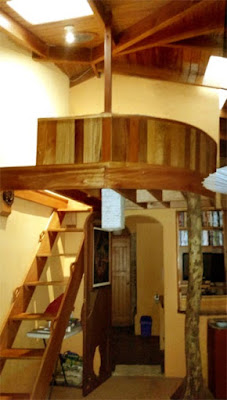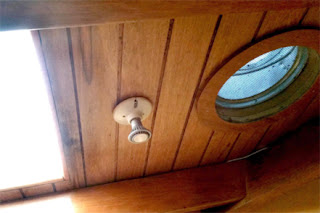 |
| My new flat look! I love it! |
 |
| At Dan's cabin |
 |
| Cousin Shelly and I at Mt. Ashland |
I admit to having had a remarkably good time, given the circumstances for my trip to the US this spring (the mastectomy) having gotten a chance to catch up with old friends and neighbors during visits to their houses and during potlucks at Diana’s.
Diana, by the way, was my "cancer doula," providing lodging and taking care of me throughout this potentially traumatic experience, and making it, instead, an amazing and transforming adventure.
Other cool things happened, too. My cousin Shelly, who was traversing the Pacific Crest Trail, interrupted her journey to stop by Callahan's restaurant at Mt. Ashland for a cozy lunch with Diana and me.
Daniel, my long-time friend and companion, generously provided a little car for me to use, which made life easier as I worked my way through all the appointments, meetings, and other things related to major surgery.
Diana, by the way, was my "cancer doula," providing lodging and taking care of me throughout this potentially traumatic experience, and making it, instead, an amazing and transforming adventure.
 |
| My cancer doula, Diana |
Other cool things happened, too. My cousin Shelly, who was traversing the Pacific Crest Trail, interrupted her journey to stop by Callahan's restaurant at Mt. Ashland for a cozy lunch with Diana and me.
Daniel, my long-time friend and companion, generously provided a little car for me to use, which made life easier as I worked my way through all the appointments, meetings, and other things related to major surgery.
 |
|
Lunch with Libby (above) and Anna (below). |
 |
| Friends creating Celtic Jam |
There were lunches and dinners with friends, a visit to Daniel’s delightful mountain cabin on his 4-wheeler, an afternoon and evening of Celtic music, sewing with Diana in her workshop, as well as a cloth dyeing workshop and shopping for fabrics, a visit to the beautiful Jackson County Extension demonstration gardens, an estate sale, John’s art show in Medford, and taking delivery of shoes, shoes, shoes (well, only 6 pairs, but it’s a great start!) for teens to wear for gym class here in Benque. If kids can’t afford gym shoes, they sometimes drop out of school because they can’t go barefoot or wear street shoes in the gym. Several people were able to find extra walking/hiking shoes in their closets, and we took them with us to Idaho to pack up and send to Belize.
Around the first of June, a couple of weeks after my mastectomy (which was on May 18, commemorating the eruption of Mt. St. Helens, which, if you look at it in a certain way, was similarly the occasion of the removal of a conical lump) I traveled by car with Diana and John from Oregon to David and Marcia’s place in Eagle Idaho, near Boise.
 |
| David plays his Diddly Bo |
While there, I rested a lot, drank beer and talked philosophy with David, played with the gorgeous “diddly bo” he had constructed, and we worked together several evenings to install all the programs I needed into the computer Daniel gave me while I was in Oregon. My old computer here in Belize was starting to sputter and stall, but with the new computer I can return to working on my sketchbook journal compilations, and other projects.
 |
| Marcia painting dragonflies on a silk scarf |
Marcia and I some lovely long chats, too, and I got to watch her producing one of her amazing painted silk scarves.
My final task of the six-week trip was to pack the donated shoes (freshly laundered!) and items I couldn’t get into my luggage into three big poly tubs to ship to Belize. David took them to the PO to mail to Texas, where they went on a container ship to Belize, then by truck to a nearby town here where I picked them up, finally, just last week.
My final task of the six-week trip was to pack the donated shoes (freshly laundered!) and items I couldn’t get into my luggage into three big poly tubs to ship to Belize. David took them to the PO to mail to Texas, where they went on a container ship to Belize, then by truck to a nearby town here where I picked them up, finally, just last week.
 |
| Some of the donated shoes. |
 |
| my tubs arrived |
 |
| You can almost see the house |
 |
| Me, post-op flat |
 |
| Full-moon dinner cruise with neighbors on Laz's pontoon boat. $10 each. |
Now I’m back to my usual tasks, providing cokes and chips for the construction crew; doing the footwork for our Belize Scholarships program for the local kiddies; joining in on community celebrations – most recently, a full-moon cruise on the lake with Laz on his pontoon boat; and tying up loose ends with the Lights for Students program.
 |
| Laz pilots the pontoon boat |
 |
| sweet scholarship kids |
So to launch the Study Center, I’m now trying to get money together for a 6’ folding table (you know, those nice durable plastic ones), four chairs, and a printer. My friend Jenny, who lives here at BIB, donated most of the cost for a computer for the kids, and we have that now, but a printer is essential.
Freddy, my friend who is foreman on the construction crew, still owes me a couple of days work to pay off the cell phone I brought him from the US, so he’ll make me some shelves and help me wire the lights over the table.
Freddy, my friend who is foreman on the construction crew, still owes me a couple of days work to pay off the cell phone I brought him from the US, so he’ll make me some shelves and help me wire the lights over the table.
 |
| This katydid looks exactly like a leaf and twigs. |
Moving right along.....The latest event in my MIcasa saga (my teeny jungle shack) was somewhere between hilarious and horrible. After ten weeks of neglect, I finally made it to my little house in the big woods, only to be greeted by an ominous termite trail leading out of the forest, across the veranda, and under the front door.
Opening the door, I discovered that there had been a termite hatch inside, and the entire inside of the house was coated with discarded termite wings (termites ditch their wings after mating). Wings were on every surface and even clinging to all the walls. They are like tiny bits of cellophane, somewhat electrostatic, and elude clean-up efforts easily. But it wasn't only termites...
The entire interior space was swagged like a Halloween horror house with dusty gray spiderwebs, festooned from one end of the house to the other. My very first act was to get a long stick and wave it around in the air until it was swirled with webs and it was possible to walk cross the room without getting strands of silk stuck to my eyelids and lips.
 |
| Termite wings everywhere! |
The entire interior space was swagged like a Halloween horror house with dusty gray spiderwebs, festooned from one end of the house to the other. My very first act was to get a long stick and wave it around in the air until it was swirled with webs and it was possible to walk cross the room without getting strands of silk stuck to my eyelids and lips.
 |
| Mouse nest under pot |
Then I noticed a chewed towel, and jute twine trailing across the room, and discovered, under an upturned pot in the dish drainer (my final cleaning act of the previous visit) a well-stuffed mouse nest made of bits of towel and jute twine, and – oh NO! – heavy white string that could only have come from my hammock, which was hanging from a nail over by the door…..Aughhhhh!
 |
| my mouse-chewed hammock |
You can imagine how the next few hours were spent. Since the hammock is where I relax after doing scrubbing or carpentering tasks, mending the hammock was high on my to-do list. The mice had chewed off most of the support strings on both ends, and gnawed seven gaping holes in the body of the hammock. Fortunately, I had a roll of nylon string used for carpentry jobs, and after only six hours of labor, my hammock was reassembled.
Every string had to be tied off, and the end support strings had to be replaced, but by the time I was exhausted from cleaning and scrubbing and dusting (and mending!), I had a hammock to rest in again. But like I said, it was really kind of humorous, with no major harm done (except to the hammock) and it makes a great story.
However, I’ll try not to let ten weeks pass between visits again – the wildlife had every right to think I’d abandoned the place.
Every string had to be tied off, and the end support strings had to be replaced, but by the time I was exhausted from cleaning and scrubbing and dusting (and mending!), I had a hammock to rest in again. But like I said, it was really kind of humorous, with no major harm done (except to the hammock) and it makes a great story.
| Heliconia plant |
Millie and I have been working on my landscaping here at Casa de la Tierra (yeah, yeah, I know, that sounds horribly pretentious, but in Spanish-speaking countries people name their houses). Right now it looks really pretty, with the wet season well begun and greenery flourishing. Here's one of my heliconia plants.
 |
| Crayola Katydid |
 |
| Wow! My very own bananas! |
All righty, enough blathering. I hope you have enjoyed this little tour of recent happenings in my life. But if you didn’t, why on earth did you read this far?!
Big hugs for you, my friend!
Renie
Renie
































